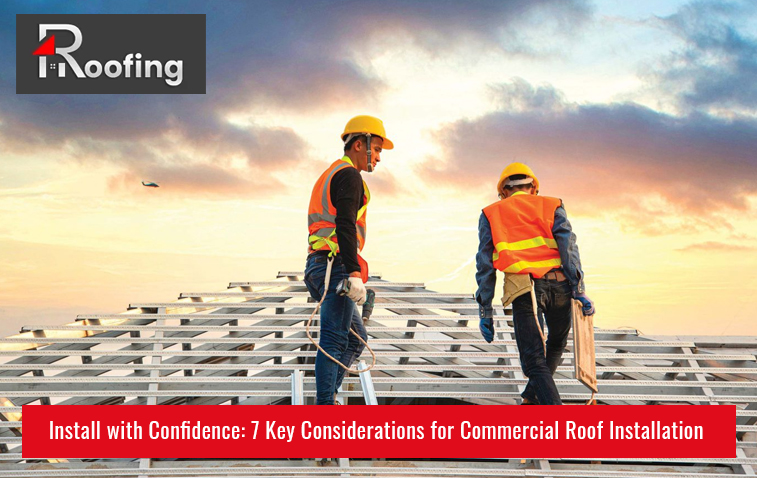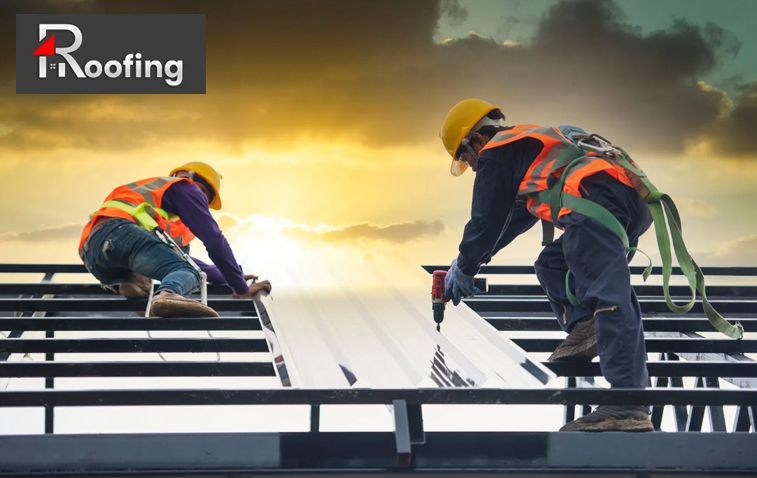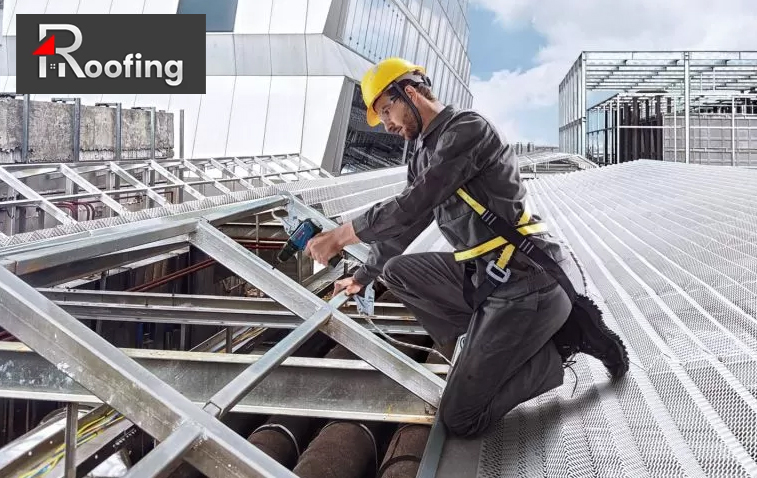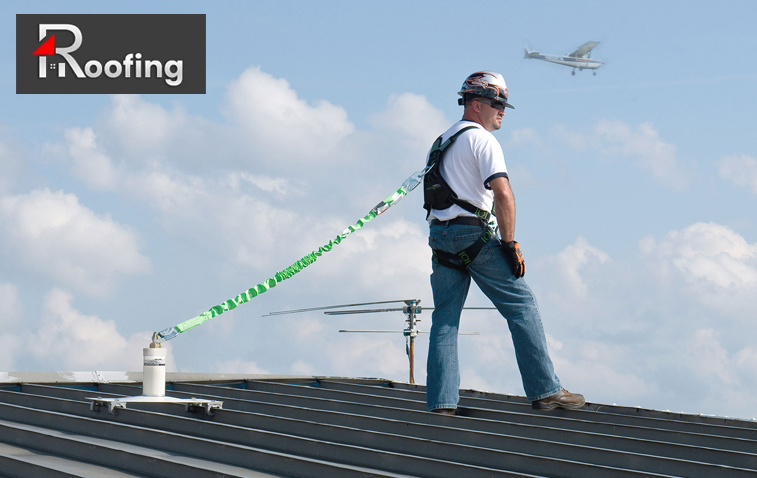Install with Confidence: 7 Key Considerations for Commercial Roof Installation
A commercial roof installation is a significant investment that requires careful planning and execution. The roof is one of the most critical components of a building, providing protection from the elements, contributing to energy efficiency, and enhancing the structure’s overall durability. To ensure a successful installation that stands the test of time, here are seven key considerations for your commercial roof project.

Choosing the Right Roofing Material
Selecting the appropriate roofing material is the foundation of a successful commercial roof installation. The material you choose will determine the roof’s durability, maintenance needs, and energy efficiency.
Common Roofing Materials:
- EPDM (Ethylene Propylene Diene Terpolymer) is known for its durability and resistance to extreme weather conditions. EPDM roofs are easy to install and repair.
- TPO (thermoplastic olefin) is popular for its energy efficiency and reflective properties. TPO is resistant to UV rays, chemicals, and punctures.
- PVC (Polyvinyl Chloride) offers excellent durability and resistance to chemicals and fire. PVC roofing is also energy-efficient and has strong reflective properties.
- Modified Bitumen: A versatile material that combines asphalt with polymerized rubber or plastic. It is durable and easy to install, with excellent waterproofing properties.
- Built-Up Roofing (BUR): Consists of multiple layers of bitumen and reinforcing fabrics. BUR is known for its durability and excellent waterproofing.
- Metal roofing provides exceptional durability and longevity. Metal roofs are fire-resistant, energy-efficient, and can be made from various metals, including steel and aluminum.
Implementation Tips:
- Climate Considerations: Choose a material suited to your local climate. For instance, TPO and PVC are excellent for hot climates due to their reflective properties, while EPDM is well-suited for cold climates.
- Building Type: Consider the specific needs of your building. For example, buildings with high foot traffic may benefit from more durable materials like modified bitumen or metal.
- Energy Efficiency: Opt for materials with high reflective properties and good insulation to enhance the building’s energy efficiency.
Understanding Building Codes and Regulations
Compliance with building codes and regulations is crucial for any commercial roof installation. These codes ensure that your roof meets safety, performance, and environmental standards.
Key Considerations:
- Local Building Codes: Familiarize yourself with local building codes that dictate materials, installation practices, and safety measures. Non-compliance can result in fines and the need for costly modifications.
- Permits and Approvals: Obtain the necessary permits and approvals before beginning the installation. This often involves submitting detailed plans and specifications to local authorities.
- Environmental Regulations: Be aware of environmental regulations that may affect your roofing material choices, such as requirements for reflective surfaces to reduce urban heat islands.
Implementation Tips:
- Consult professionals: work with architects, engineers, and roofing professionals who are familiar with local codes and regulations.
- Stay updated: Building codes and regulations can change over time. Stay informed about any updates or changes that may impact your project.
- Documentation: Keep thorough records of all permits, approvals, and inspections to ensure compliance and provide a reference for future maintenance.

Roof Design and Drainage Systems
A well-designed roof and an efficient drainage system are essential for the long-term performance of your commercial roof. Proper design and drainage prevent water accumulation, which can lead to leaks and structural damage.
Key Design Elements:
- Slope and Pitch: Ensure the roof has an adequate slope or pitch to facilitate water runoff. Flat roofs require slight slopes to prevent standing water.
- Drainage Systems: Incorporate effective drainage systems, such as gutters, downspouts, and internal drains, to channel water away from the roof surface.
- Expansion Joints: Include expansion joints in the design to accommodate thermal expansion and contraction, reducing the risk of cracks and leaks.
Implementation Tips:
- Professional Design: Engage a professional to design the roof and drainage system, ensuring all elements work together seamlessly.
- Regular Maintenance: Schedule regular maintenance to keep drainage systems clear of debris and functioning properly.
- Material Selection: Choose roofing materials that complement the design and drainage requirements of the roof. For example, some materials may be better suited to handle the drainage demands of a flat roof.
Insulation and energy efficiency
Proper insulation is critical for the energy efficiency and thermal performance of a commercial roof. Good insulation helps maintain indoor temperatures, reduces energy consumption, and contributes to occupant comfort.
Key Considerations:
- Insulation Types: Common insulation materials for commercial roofs include polyisocyanurate (polyiso), expanded polystyrene (EPS), and extruded polystyrene (XPS).
- R-Value: The R-value measures the insulation’s resistance to heat flow. Higher R-values indicate better insulating properties.
- Installation Techniques: Proper installation techniques are essential to ensuring the insulation performs as expected. This includes avoiding gaps and ensuring a continuous insulation layer.
Implementation Tips:
- Assess Building Needs: Evaluate the building’s specific insulation needs based on climate, building use, and energy goals.
- Layered Approach: Consider a layered approach to insulation, combining different materials to achieve optimal thermal performance.
- Energy Audits: Conduct energy audits to identify areas for improvement and ensure the insulation strategy aligns with overall energy efficiency goals.
Ventilation Systems
Effective ventilation is essential for preventing moisture buildup and maintaining the health of your commercial roof. Proper ventilation systems help regulate temperature and humidity levels, preventing issues such as mold growth and material degradation.
Key Considerations:
- Vent Types: Common roof ventilation options include ridge vents, soffit vents, and turbine vents. Each type has specific applications and benefits.
- Airflow Balance: Ensure a balance between intake and exhaust vents to promote continuous airflow throughout the roof structure.
- Moisture Control: Adequate ventilation helps control moisture levels, reducing the risk of condensation and associated problems.
Implementation Tips:
- Design Integration: Integrate ventilation systems into the overall roof design to ensure they function effectively and do not detract from the building’s aesthetics.
- Maintenance: Regularly inspect and maintain ventilation systems to ensure they remain clear of obstructions and function properly.
- Professional Guidance: Consult with ventilation experts to design a system that meets the specific needs of your commercial building.
Durability and longevity
The durability and longevity of your commercial roof depend on several factors, including material quality, installation practices, and ongoing maintenance. Investing in durable materials and high-quality installation can result in a longer-lasting roof with fewer repairs over time.
Key Considerations:
- Material Selection: Choose materials known for their durability and resistance to environmental factors such as UV radiation, wind, and precipitation.
- Quality Installation: Ensure the roof is installed by experienced professionals who follow best practices and manufacturer guidelines.
- Regular Inspections: Schedule regular inspections to identify and address minor issues before they escalate into significant problems.
Implementation Tips:
- Manufacturer Warranties: Review and understand the warranties offered by roofing material manufacturers. Ensure the warranty covers materials and installation.
- Preventive Maintenance: Implement a preventive maintenance program to keep the roof in good condition and extend its lifespan.
- Weather Considerations: Consider local weather patterns and potential hazards when selecting materials and designing the roof. For example, areas prone to heavy snowfall may require roofs with higher load-bearing capacities.

Safety Measures and Accessibility
Safety is paramount during the installation and maintenance of a commercial roof. Implementing proper safety measures protects workers and ensures compliance with regulations.
Key Safety Measures:
- Fall Protection: Use fall protection systems such as guardrails, safety nets, and personal fall arrest systems to protect workers from falls.
- Access Points: Design safe access points to the roof, such as ladders and rooftop hatches, to facilitate maintenance and inspections.
- Training and Equipment: Ensure workers are trained in safety protocols and equipped with the necessary safety gear, such as harnesses, helmets, and gloves.
Implementation Tips:
- Safety Plans: Develop and implement comprehensive safety plans that outline procedures for working at heights, handling materials, and responding to emergencies.
- Regular Training: Conduct regular safety training sessions to keep workers informed about the latest safety practices and regulations.
- Compliance: Stay up-to-date with Occupational Safety and Health Administration (OSHA) regulations and other relevant safety standards to ensure compliance.
Conclusion
A successful commercial roof installation requires careful consideration of multiple factors, from material selection and building codes to design and safety measures. By paying attention to these key considerations, you can ensure a durable, efficient, and compliant roofing system that protects your building and enhances its performance. Planning and executing your roof installation with confidence will result in a long-lasting investment that stands up to the demands of time and weather.




